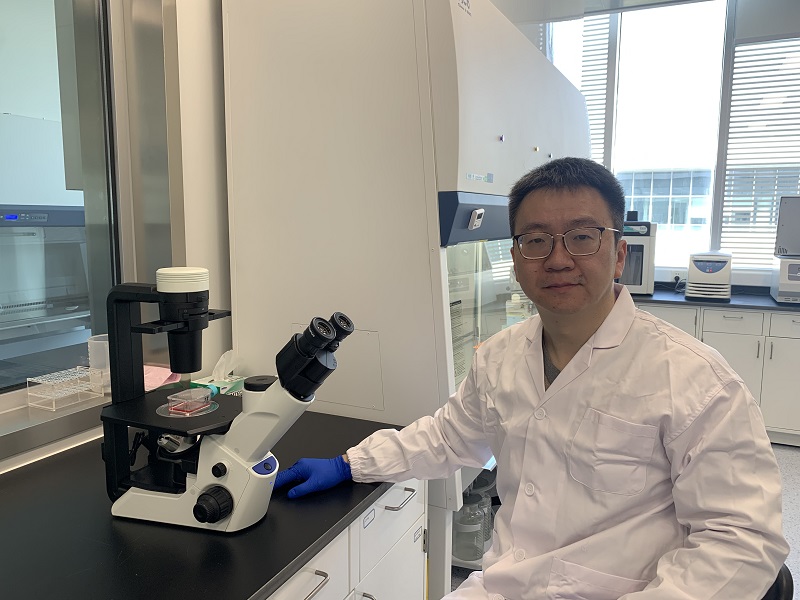
Linfeng Huang in his laboratory on the Duke Kunshan campus
By John Butcher
Staff writer
The topic of ribonucleic acid (RNA) therapeutics has become a part of the news agenda in recent months due to its use in Covid-19 vaccines, but less is known about this burgeoning medical technology’s development in Asia.
The heart of research and development of RNA-based therapeutics there is Kunshan, home to a host of companies using RNA technology including Suzhou Ribo Life Science, China’s top biotech company in the development of RNA-based medicines.
At the center sits the laboratory of Linfeng Huang, associate professor of biology at Duke Kunshan, whose research is at the cutting edge of it all.
Huang has spent more than a decade researching RNA, from its role in preventing genetic diseases to its use in creating environmentally friendly pesticides. He’s now on the verge of producing a technology that would make it faster, easier and cheaper to produce RNA, thereby vastly increasing access to it in the future.
‘It will be the first bioengineering to produce a kind of highly functional RNA using bacterial fermentation’ he said.
RNA therapeutics is a developing strand of medicine that uses ribonucleic acid, a key genetic material bridging DNA and protein that can be used in vaccines and to treat various diseases. Before its emergency approval for use in Covid-19 vaccines, it had been used in just a handful of drugs targeting genetic diseases.
Huang’s research focus has been on the manufacture of small pieces of RNA to inhibit gene expression or switch off malfunctioning genes through targeting messenger RNA (mRNA), a single-stranded molecule of RNA that corresponds to the genetic sequence of a gene. Man-made mRNAs can also be used to produce extra proteins in the body to induce immune response or to complement the deficiency of lacking a certain gene.
The advantages of RNA therapeutics over other forms or medicine are that they are easy to design and produce, with clearer functions and fewer side effects, which also makes them generally more effective, according to Huang.
By comparison, ‘traditional medicines, mainly proteins and small chemicals, are difficult to select and develop, and for many traditional drugs it is not known exactly how they work,’ he said.
The downside is that synthetic RNA is ‘extremely unstable’ and expensive to manufacture, while the large size of RNA biomolecules makes it difficult for them to readily cross cell membranes to enter cells and to reach a targeted organ.
Childhood dream
Huang’s interest in science has been longstanding. ‘Ever since childhood, I have been curious and passionate about science and dreamed to become a scientist,’ he said.
That dream began to take shape in 2003, when he graduated from the School of Biological Sciences of China Agricultural University in Beijing.
From there Huang moved to Oxford, England, as a visiting researcher in Hui Wang’s group at the U.K. Centre for Ecology and Hydrology, before spending four years studying for a Ph.D. at the John Innes Centre’s Sainsbury Laboratory in Norwich under renowned British plant scientist and geneticist Sir David Baulcombe.
It was there that his interest in RNA began to emerge; he began studying a newly discovered plant-specific, DNA-dependent RNA polymerases. In Norwich, Huang became the first to reveal the biochemical properties of this new type of RNA polymerase, and began focusing his research on the biology and technology of RNA interference (RNAi), a natural means of changing the activity of genes.

Huang’s career since has been varied, including work on producing RNA-based cancer medicines and investigating its use in tackling the Zika infection, which can lead to infants being born with microcephaly (when their head is much smaller than expected) and other congenital malformations.
In 2018, he also became a biotech entrepreneur, founding Xiaomo Biotech Ltd. in the Hong Kong Science Park, using technology he invented to ‘develop revolutionary RNAi products for drug discovery and agricultural applications that could make a significant impact on the RNAi market.’
Huang made an important advancement in RNA therapeutical development in 2019 with colleagues from City University of Hong Kong, where he was associate professor in the Department of Biomedical Sciences before joining Duke Kunshan. They developed an efficient siRNA delivery tool for combinatorial cancer therapy, overcoming one limitation of the technology, which is the difficulty in delivering it to patients.
Now, at his laboratory at Duke Kunshan, he is on the edge of a new breakthrough that could be a catalyst for expanding the development and use of this burgeoning technology.
Huang and his team have demonstrated the ability of large-scale small interfering RNA (siRNA) production using bacterial fermentation. Essentially, this involves producing synthetic RNA with the use of microbes, ‘like fermenting beer,’ making it cheaper and easier to produce it anywhere, which also means there would be less need to transport it.
The process uses ‘bacterial cells as the ‘factory’ to make highly efficient and specific siRNAs,’ that can be used for a broad range of RNA applications, including silencing specific genes to prevent genetic diseases, said Huang.
‘This technology uses a simple equipment setup, cheap materials, and an environmentally friendly process,’ he added, meaning they can be produced cost effectively and on a large scale.
The bacteria-made siRNAs are also relatively stable, compared to other RNA therapeutics, making them especially suitable for targeting cancer and infectious diseases, he said.
The outcome of this could be to make this burgeoning technology cheaper and more accessible, opening up its use for a broader range of medical conditions among a larger part of the world’s population.

